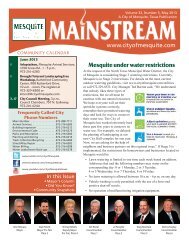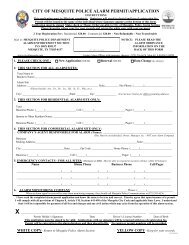airport/documents/Mesquite Master Plan Final.pdf - The City of ...
airport/documents/Mesquite Master Plan Final.pdf - The City of ...
airport/documents/Mesquite Master Plan Final.pdf - The City of ...
You also want an ePaper? Increase the reach of your titles
YUMPU automatically turns print PDFs into web optimized ePapers that Google loves.
development by the <strong>City</strong>. New hangar<br />
and ground leases will need to be<br />
established in such a manner that the<br />
<strong>City</strong> will be able to amortize its<br />
development costs over a reasonable<br />
time period. At the current time, land<br />
lease rates are $0.08 per square-foot per<br />
year. This rate could be increased to<br />
$0.20 per square-foot per year and be in<br />
line with other <strong>airport</strong>s due to utility<br />
availability.<br />
Should the <strong>City</strong> decide to construct Thangar<br />
facilities, costs can generally<br />
equal $30,000 per unit. Thus, a 20-unit<br />
T-hangar could cost as much as<br />
$600,000 to construct. To retire the<br />
bond debt service for the construction <strong>of</strong><br />
a 20-unit facility over a 15-year period<br />
at a six percent interest rate, individual<br />
hangar rates would need to be at least<br />
$200 per month. This does not include<br />
the construction <strong>of</strong> additional taxilane<br />
access to the hangars. T-hangar<br />
taxilanes, however, may be funded at 90<br />
percent by TxDOT (state or federal<br />
grants-in-aid).<br />
If the <strong>City</strong> does not construct the<br />
proposed hangar facilities, the <strong>City</strong>’s<br />
only capital cost would be 10 percent <strong>of</strong><br />
the taxilane construction (the<br />
remaining 90 percent would come from<br />
federal or state grants). <strong>The</strong> <strong>City</strong> has<br />
been open to the development <strong>of</strong><br />
privately-owned hangars in the past.<br />
Privately-owned facilities <strong>of</strong>fer the <strong>City</strong><br />
significant savings.<br />
<strong>Mesquite</strong> Metro Airport also has a<br />
unique opportunity to generate greater<br />
revenue through the development <strong>of</strong><br />
commercial uses on <strong>airport</strong> property.<br />
<strong>The</strong> proposed acquisition <strong>of</strong> the 80-acre<br />
6-14<br />
parcel west <strong>of</strong> the <strong>airport</strong> could support<br />
commercial business operations. <strong>The</strong>se<br />
uses can generate lease rates <strong>of</strong> up to<br />
$0.30 per square-foot per year.<br />
Cash flow projections indicate future<br />
revenues should rise at a greater rate<br />
than expenses. <strong>The</strong> analysis presents<br />
average annual projections for each<br />
planning horizon. As presented in<br />
Table 6C, the <strong>City</strong> should be capable <strong>of</strong><br />
obtaining sufficient operating revenues<br />
to <strong>of</strong>fset expenses. Revenue and<br />
expense projections have been made for<br />
the end <strong>of</strong> each planning horizon. Thus,<br />
each planning horizon considers the<br />
facilities and services required to meet<br />
demand requirements.<br />
Expenses<br />
Future expenses could vary depending<br />
upon the <strong>City</strong>’s desire to develop,<br />
operate, and maintain additional<br />
hangars. Similarly, future expenses<br />
could be higher if the <strong>City</strong> develops on<strong>airport</strong><br />
commercial properties. It is<br />
likely that revenue bonds would be<br />
necessary to fund this construction.<br />
Also, the <strong>City</strong> could expect maintenance<br />
costs and administrative costs<br />
associated with operating the facilities.<br />
As the <strong>airport</strong> continues to grow,<br />
additional employees may ultimately be<br />
needed. Most successful general<br />
aviation <strong>airport</strong>s have at least one fulltime<br />
<strong>airport</strong> manager. Often, the<br />
<strong>airport</strong> staff can include up to ten<br />
employees. <strong>Mesquite</strong> Metro Airport’s<br />
future staffing requirements could<br />
reach seven employees over the long<br />
term. Potential <strong>airport</strong> employees could




